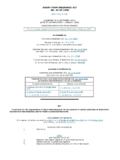Transcription of SEC Approves NYSE 3-Day Buy-In Rule For Failures To ...
1 SEC Approves NYSE 3-Day Buy-In Rule For Failures To Deliver And Adds Section That Ensures Closeout Requirements Of regulation sho . DTCC To Automate and Streamline Buy-In Notification For Securities. December 2, 2005 /M2 PRESSWIRE/ , , announced today that the Securities and Exchange Commission has approved an order approving a rule change for mandatory buy-ins, must receive deliveries and related amendments. On November 28th the Securities and Exchange Commission approved rule changes to NYSE Rules 282, 284, 289 and 290. The approved changes permit members and member organizations to initiate buy-ins, reduce the waiting period to initiate a Buy-In from 30 days to 3 days, and to otherwise provide more standardized and consistent Buy-In rules and procedures. The member firm that initiates the Buy-In is now allowed to execute the Buy-In within 3 days if the security that is failing to deliver does not arrive by 2:30pm on the 3rd day.
2 The amendment also ensures that members comply with the closeout requirements of regulation sho . Members are obligated to comply with the marking, locate and delivery requirements of regulation sho for short sales of equity securities. The hope is that speeding up the forced cover of naked short sales and other Failures to deliver will reduce systemic problems that have led to hundreds of companies appearing on regulation sho Threshold Security lists and nearly $6 billion in Failures -to-deliver on any given day. In addition, on September 14th, The Depository Trust & Clearing Corporation (DTCC) announced it had developed a new Web-based system that will standardize and automate the creation, delivery and tracking of Buy-In notices for the securities industry and provide a single point of entry for brokers sending or receiving Buy-In notices.
3 The new service, offered through The Depository Trust Company (DTC), a subsidiary of DTCC, is called SMART/Track for Buy-ins and improves upon an earlier DTC system, the Participant Exchange (PEX) service, which was a messaging facility only for buy-ins. The new service is subject to regulatory approval. A large number of Buy-In notices of intent are routinely sent out by firms. During an eight-day period in February, almost 2,300 CNS Buy-In notices were transmitted each day via PEX. During the same period, more than 2,000 non-CNS buy-ins were transmitted per day through PEX as well. The new service is expected to streamline and speed up the communication process between senders and receivers of buy-ins. By standardizing the process, SMART/Track for Buy-ins should boost efficiencies, reduce cost and risk and eliminate the time involved in manually sending and tracking Buy-In notices.
4 Buy-In notifications are sent when a broker fails to deliver securities on time. The broker expecting the securities sends a Buy-In notice to the broker that is failing to deliver, informing them that the broker failing to receive the securities will go into the market to buy them and hold the delivering broker liable for any price variation. Brokers are responsible for any difference between price of the original transaction and the price of the Buy-In . The browser-based system will provide a central point for inputting information, sending notifications and tracking the life of a Buy-In notice. It will retain data for seven years for broker-to-broker Buy-In notices, which includes CNS Buy-In notices, as well as non-CNS buy-ins. Online notification of CNS executions is expected to eliminate the delays found in today's Buy-In process and improve straight-through processing for buy-ins.
5 Participants getting bought in will receive information much sooner with the automated service, which will minimize the risks associated with getting prices either late in the day or early the next morning, as it sends Buy-In information to allocated brokers in real time. About is a service designed to help bonafide shareholders of publicly traded US companies fight naked short selling. Naked short selling is the illegal act of short selling a stock when no affirmative determination has been made to locate shares of the stock to hypothecate in connection with the short sale. has built a proprietary database that uses Threshold list feeds from NASDAQ, AMEX and NYSE to generate detailed and useful information to combat the naked short selling problem. For the first time, actual trade by trade data is available to the public that shows the attempted size, actual size, price and average value of short sales in stocks that have been shorted and naked shorted.
6 This information is valuable in determining the precise point at which short sellers go out-of-the-money and start losing on their short and naked short trades. has built a massive database that collects, analyzes and publishes a proprietary SqueezeTrigger for each stock that has been shorted, The SqueezeTrigger database of nearly 500,000,000 short sale transactions goes back to January 1, 2005 and calculates the exact price at which the Total Short Interest is short in each stock. This data was never before available prior to January 1, 2005 because the Self Regulatory Organizations (primary exchanges) guarded it aggressively. After the SEC passed regulation sho , exchanges were forced to allow data processors like to access the data. The SqueezeTrigger database collects individual short trade data on over 7,000 NYSE, AMEX and NASDAQ stocks and general short trade data on nearly 8,000 OTCBB and PINKSHEET stocks.
7 Each month the database grows by approximately 50,000,000 short sale transactions and provides investors with the knowledge necessary to time when to buy and sell stocks with outstanding short positions. By tracking the size and price of each month s short transactions, provides institutions, traders, analysts, journalists and individual investors the exact price point where short sellers start losing money. All material herein was prepared by , based upon information believed to be reliable. The information contained herein is not guaranteed by to be accurate, and should not be considered to be all-inclusive. The companies that are discussed in this opinion have not approved the statements made in this opinion. This opinion contains forward-looking statements that involve risks and uncertainties. This material is for informational purposes only and should not be construed as an offer or solicitation of an offer to buy or sell securities.
8 Is not a licensed broker, broker dealer, market maker, investment banker, investment advisor, analyst or underwriter. Please consult a broker before purchasing or selling any securities viewed on or mentioned herein. may receive compensation in cash or shares from independent third parties or from the companies mentioned. affiliates, officers, directors and employees may also have bought or may buy the shares discussed in this opinion and may profit in the event those shares rise in value. Market commentary provided by Thomas Ronk. will not advise as to when it decides to sell and does not and will not offer any opinion as to when others should sell; each investor must make that decision based on his or her judgment of the market. This release contains "forward-looking statements" within the meaning of Section 27A of the Securities Act of 1933, as amended, and Section 21E the Securities Exchange Act of 1934, as amended and such forward-looking statements are made pursuant to the safe harbor provisions of the Private Securities Litigation Reform Act of 1995.
9 "Forward-looking statements" describe future expectations, plans, results, or strategies and are generally preceded by words such as "may", "future", "plan" or "planned", "will" or "should", "expected," "anticipates", "draft", "eventually" or "projected". You are cautioned that such statements are subject to a multitude of risks and uncertainties that could cause future circumstances, events, or results to differ materially from those projected in the forward-looking statements, including the risks that actual results may differ materially from those projected in the forward-looking statements as a result of various factors, and other risks identified in a companies' annual report on Form 10-K or 10-KSB and other filings made by such company with the Securities and Exchange Commission. You should consider these factors in evaluating the forward-looking statements included herein, and not place undue reliance on such statements.
10 The forward-looking statements in this release are made as of the date hereof and undertakes no obligation to update such statements. Contact: Thomas Ronk / CEO / / (800) 715-9999 /



